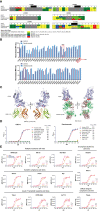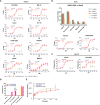Preclinical characterization of a novel investigational monoclonal antibody CM313 with potent CD38-positive cell killing activity
- PMID: 38765013
- PMCID: PMC11099226
- DOI: 10.3389/fimmu.2024.1410457
Preclinical characterization of a novel investigational monoclonal antibody CM313 with potent CD38-positive cell killing activity
Abstract
Introduction: CM313 is currently under clinical investigation for treatments of multiple myeloma, systemic lupus erythematosus, and immune thrombocytopenia. We aimed to report the preclinical profile of the novel therapeutic anti-CD38 monoclonal antibody (mAb) CM313, with an emphasis on the difference with other CD38-targeting mAb.
Methods: The binding of CM313 to CD38 recombinant protein across species was assessed using ELISA. The binding of CM313 to CD38-positive (CD38+) cells was detected using flow cytometry assays. CM313-induced complement-dependent cytotoxicity (CDC), antibody-dependent cellular cytotoxicity (ADCC), antibody-dependent cellular phagocytosis (ADCP) and apoptosis on different CD38+ cells were assessed by LDH release assays or flow cytometry assays. The effect of CM313 on CD38 enzymatic activity was measured using fluorescence spectroscopy. CM313 immunotoxicity in human blood was assessed using flow cytometry assays, ELISA, and LDH release assays. Anti-tumor activity of CM313 was assessed in multiple mouse xenograft models. Safety profile of CM313 were evaluated in cynomolgus monkeys and human CD38 transgenic (B-hCD38) mice.
Results: There exist unique sequences at complementarity-determining regions (CDR) of CM313, which facilitates its affinity to CD38 is consistently higher across a spectrum of CD38+ cell lines than daratumumab. In vitro studies showed that CM313 induces comparable killing activity than daratumumab, including ADCC, CDC, ADCP, apoptosis induced by Fc-mediated cross-linking, and effectively inhibited the enzymatic activity of CD38. However, CM313 showed more potent CDC than isatuximab. In vivo, CM313 dose-dependently inhibited xenograft tumor growth, both as a monotherapy and in combination with dexamethasone or lenalidomide. Furthermore, CM313 was well tolerated with no drug-related clinical signs or off-target risks, as evidenced by 4-week repeat-dose toxicology studies in cynomolgus monkeys and B-hCD38 mice, with the later study showing no observed adverse effect level (NOAEL) of 300mg/kg once weekly.
Discussion: CM313 is a novel investigational humanized mAb with a distinct CDR sequence, showing comparable killing effects with daratumumab and stronger CDC activity than isatuximab, which supports its clinical development.
Keywords: CD38; CM313; monoclonal antibody; novel; preclinical.
Copyright © 2024 Liu, Yu, Sun, Song, Li, He, Wang, Xu, Wang and Chen.
Conflict of interest statement
Authors WL, JY, QS, YL, YH, YW, GX, CW, and BC were employed by the company Keymed Biosciences Chengdu Limited. The remaining authors declare that the research was conducted in the absence of any commercial or financial relationships that could be construed as a potential conflict of interest. The authors declare that this study received funding from the company Keymed Biosciences Chengdu Limited. The funder had the following involvement in the study: study design, collection, analysis, interpretation of data, research, authorship, and publication of this article.
Figures




Similar articles
-
Combining CD38 antibody with CD47 blockade is a promising strategy for treating hematologic malignancies expressing CD38.Front Immunol. 2024 Jun 25;15:1398508. doi: 10.3389/fimmu.2024.1398508. eCollection 2024. Front Immunol. 2024. PMID: 38983860 Free PMC article.
-
CD38 Antibodies in Multiple Myeloma: Mechanisms of Action and Modes of Resistance.Front Immunol. 2018 Sep 20;9:2134. doi: 10.3389/fimmu.2018.02134. eCollection 2018. Front Immunol. 2018. PMID: 30294326 Free PMC article. Review.
-
Preclinical anti-tumour activity of HexaBody-CD38, a next-generation CD38 antibody with superior complement-dependent cytotoxic activity.EBioMedicine. 2023 Jul;93:104663. doi: 10.1016/j.ebiom.2023.104663. Epub 2023 Jun 26. EBioMedicine. 2023. PMID: 37379657 Free PMC article.
-
SAR442085, a novel anti-CD38 antibody with enhanced antitumor activity against multiple myeloma.Blood. 2022 Feb 24;139(8):1160-1176. doi: 10.1182/blood.2021012448. Blood. 2022. PMID: 35201323
-
Immunomodulatory effects of CD38-targeting antibodies.Immunol Lett. 2018 Jul;199:16-22. doi: 10.1016/j.imlet.2018.04.005. Epub 2018 Apr 24. Immunol Lett. 2018. PMID: 29702148 Review.
Cited by
-
Monoclonal anti-CD38 therapy in human myeloma: retrospects and prospects.Front Immunol. 2025 Feb 12;16:1519300. doi: 10.3389/fimmu.2025.1519300. eCollection 2025. Front Immunol. 2025. PMID: 40013150 Free PMC article. Review.
References
MeSH terms
Substances
LinkOut - more resources
Full Text Sources
Research Materials

